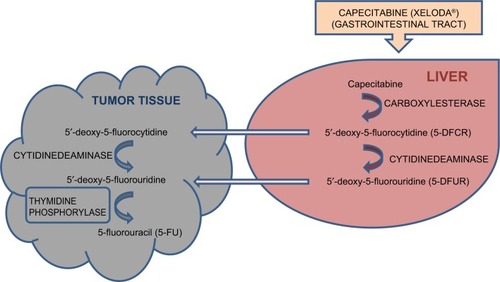Figures & data
Figure 1 Metabolic conversion of the prodrug capecitabine to the active antimetabolite moiety, 5-fluorouracil.

Figure 2 Immunohistochemistry showing TP expression in carcinoma of the breast (magnification, 400×). Representative images of immunohistochemistry staining patterns for mixed nuclear/cytoplasmic TP protein in normal epithelium and in primary or metastatic lesions.
Abbreviations: DCIS, ductal carcinoma in situ; TP, thymidine phosphorylase.

Table 1 Patient tumor characteristics
Table 2 Relationship between patient ER-positive/negative receptor status and tumoral TP expression, and the clinical benefit to a capecitabine-based chemotherapeutic regimen measured as TTP
